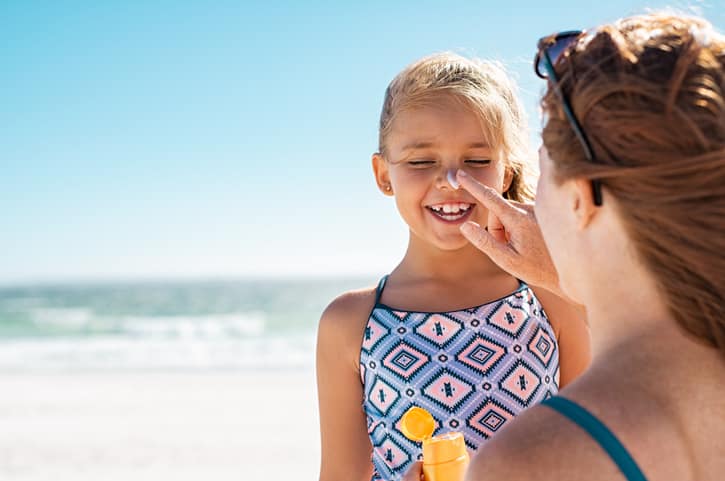Skin Care in the Sunshine State: A Floridian’s guide to care for sunburns, bug bites, rashes and birthmarks
Blue skies, emerald waters, eternal sunshine… we’re lucky to call Florida home, but living here does come at a price—the same outdoors that gives us so much pleasure can wreak havoc on our skin. From unforgiving UV rays cloaked in our abundant sunshine to the bugs that can plague our sunsets, caring for your family’s skin can pose a challenge during Florida’s warm months.
While some bug bites and sunburns can be handled at home, some situations might call for a visit to your pediatrician or a referral to your pediatric dermatologist. How can you tell the difference? Read on for our guide on sun care, bug bite care and rashes.

In Case You’re Interested:
>> Super Fun Family Restaurants
>> Cheap Family Fun
>> Orlando Hotels with Waterparks
Fun in the Sun
The best way to care for a sunburn is not to get one in the first place. Dr. Tace Rico, a board-certified pediatric dermatologist and Medical Director at AdventHealth for Children’s pediatric dermatology practice in Orlando, explains that it’s crucial to use the right type and amount of sunscreen and know when to reapply it. For an easy way to remember sun care, Dr. Rico points to a successful Australian skin care program called “Slip, Slop, Slap, Seek and Slide.”
- Slip on hats and clothes that are labeled “UPF,” which is like SPF for fabric.
- Slop on the sunscreen liberally; adults should be applying about a shot-glass worth each time, explains Dr. Rico. Make sure you choose a broad-spectrum brand (that covers both UVA and UVB rays) and is water-resistant. Sprays are not recommended but if you do choose to use a spray sunscreen, bring the nozzle right up to the skin before spraying, and make sure you rub the spray over your skin. Reapply every two hours, especially if you’re sweating or are in water.
- Slap on a wide-brimmed hat to cover your ears and the parting in your hair.
- Seek shade under an umbrella or tent if you are by the water.
- Slide on a pair of sunglasses to prevent sun damage to your eyes.
As Florida and parenting veterans, you may practice much of this already. But if you’ve lost track of time at a poolside barbecue and now have to soothe a sunburnt kiddo, try soaking them in a cool bath or applying aloe vera. Pro tip: Try refrigerating the aloe vera. You can also try using fragrance-free, gentle lotions to calm the skin and Ibuprofen for help with associated pain.
Call your pediatrician if a child develops a fever, headache, dizziness, lethargy or nausea. Those signs can point to a much more serious condition like sun poisoning, Dr. Rico says.
Bug Bites
Nothing says Florida quite like a late-afternoon cloudburst … but no one enjoys the clouds of mosquitoes that can plague our rainy season.
Many of us seek out organic herbal-type products thinking they are better for our little ones and the environment, but the American Academy of Pediatrics recommends using a DEET-based bug repellant to truly be protected from mosquito bites.
The biggest problem with kids and bug bites isn’t the bite as much as its aftermath. “When you get bug bites, young kids tend to scratch until areas bleed and open,” Dr. Rico explains. She recommends using an over-the-counter hydrocortisone cream to reduce itchiness and keeping the bite covered with a Band-Aid. If the bug bites result in a large, angry, blistered reaction, you can give your child an antihistamine like Claritin, Xyzal or Benadryl.
Call your pediatrician if your child complains of severe pain or shows swelling or a redness spreading up the leg or arm. These signs may indicate an infection.
Rashes
A lot of childhood rashes that parents see are associated with viral fever, and most go away on their own. Others are caused by contact dermatitis—by anything from too much handwashing to baby drool around the mouth or using a new detergent with a harsh fragrance. Mild irritant rashes may improve with lotions but, if not responding, should be seen by the pediatrician.
Call your pediatrician or an allergist if fever is involved or the rash is accompanied by scratching that does not go away.
When it comes to birthmarks, however, Dr. Rico cautions parents to get an early diagnosis so they can take advantage of crucial early-stage treatments.
“It’s really important to talk to your doctor about a care treatment plan for birthmarks,” says Dr. Rico, explaining that the word “birthmark” is a blanket term for widely varying skin conditions that have very different treatment plans and outcomes.
“We want to make sure a parent is not settling with the term ‘birthmark,’” Dr. Rico says. “We want parents to have a medical diagnosis, know options for care and take control of their children’s care.”
For more information and questions about how to handle your child’s unique skincare concerns, connect with AdventHealth for Children’s pediatric dermatology practice.
More Health + Wellness

